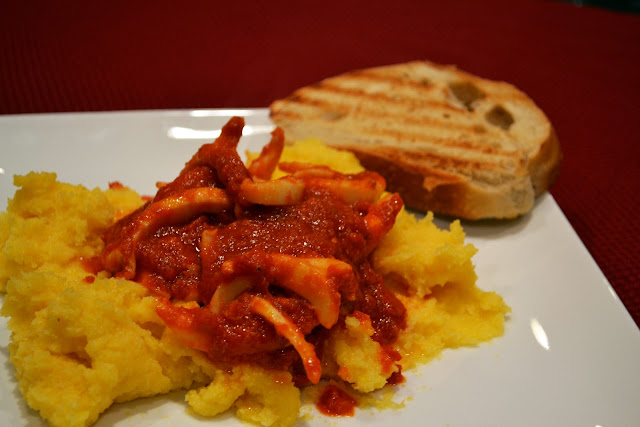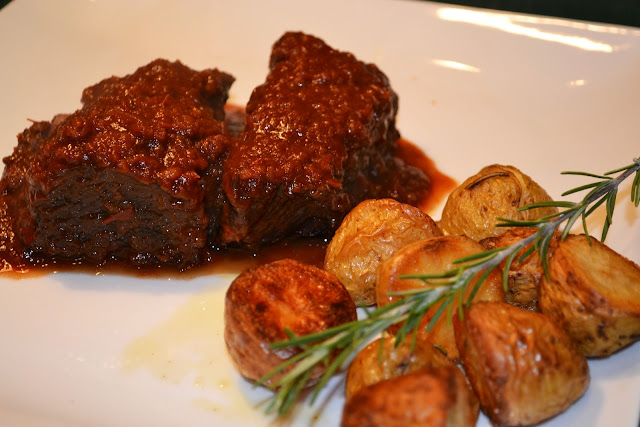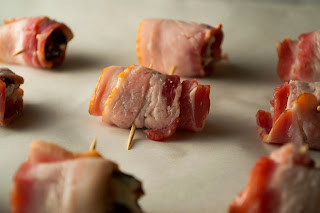Seppie in umido con polenta
Seafood had always been a passion of mine and a costant presence in my family cooking. Besides being, for the most part, healthy and fairly simple to cook, seafood allows a certain degree of creativity and versatility. One element of cooking that I particularly value and enjoy is the simple ingredients and the way of cooking them. This finds its root in very poor generations of families during war times and other periods of economic depression, where families had to use ingredients found locally at a very cheap price. By default these ingredients had to be extremely fresh. These two elements, in my opinion, happen to be two golden rules of successful and delicious recipes, fresh and local ingredients. This is particularly true with the recipe I chose today. In fact I found it very "interesting" for a lack of a better word, how traditional poor people food, so tasty and authentic, got so "glamorous" and "trendy" in so many restaurants worldwide. Cornmeal should not be very expensive at all, but call it "polenta" and it assumes a whole different connotation. I think this phenomena has affected the wine culture as well, where something so simple and enjoyable, became "trendy" and, as a consequence, more expensive.
One other interesting but fun challenge I came accross lately is the generalization of some food, seafood in this case. I used cuttlefish for this recipe, but many friends were suggesting that squid was what I needed, where in fact "seppie" and "calamari" are very distinct types of fish, even if they belong to the same family :)
In many Venetian restaurants seppie are very popular prepared grilled, cooked with risotto with black ink ( coming soon here) and, of course, with tomato sauce and polenta.
Ingredients:
1.5 lbs of cuttlefish
1.5 lbs of chopped fresh toamtoes
1/2 cup of dry white wine
1/2 onion diced
1 garlic clove
salt
pepper
extra virgin olive oil
For the Polenta:
500 grams of corn flour
8 cups water
After having cleaned the cuttlefish, cut them into strips no larger than half an inch thick. In a large pot simmer the oil together with the garlic clove finely minced and the onion, until both are of a golden color. Next add the cuttlefish and let them cook covered at a medium temperature for about 5 minutes, until they release some juice. Add the white wine and let it simmer for another two minutes. Finally, add the tomatoes and let it cook for another 15 minutes. If the sauce dries up fast, add the a little water, but the consistency at the end should not be too liquid.
For the polenta, many people reccomend the white one. I chose the yellow one, because I like the taste and it adds a nice color contrast to the presentation.
The traditional method for making polenta involves cooking it slowly on the stovetop until it thickens to the appropriate texture. This method requires constant stirring to avoid having the polenta stick to the pot.
Start by boiling water in a deep pot, pouring a spoonful of salt. Next drop the flour stirring constantly with a whisk. When everything is dissolved and homogeneous, cook stirring constantly for about an hour with a special wooden stick and lifting the polenta from the bottom up. The polenta is cooked when the edges begin to peel off. If it becomes too thick during cooking, add a little boiling water. Pour the cooked polenta into the appropriate platter and serve hot. You can also buy ready made polenta at the store and the mixing process would be much faster. Pair up with a nice white wine of your choice.




I love seppie! Too bad they are so difficult to find...
ReplyDeleteIndeed, cuttlefish are a rarity in the US, so many of us resort to squid as a substitute. Too bad, because as you say, it's a very different thing…
ReplyDeleteFunny too, how formerly poor ingredients have become expensive 'gourmet' items!